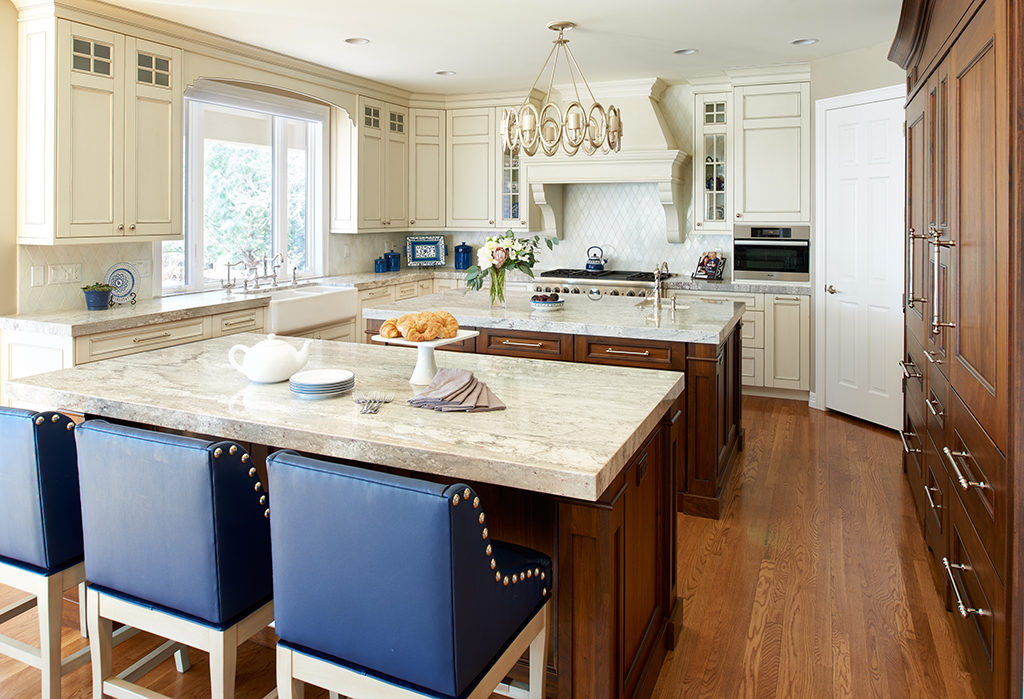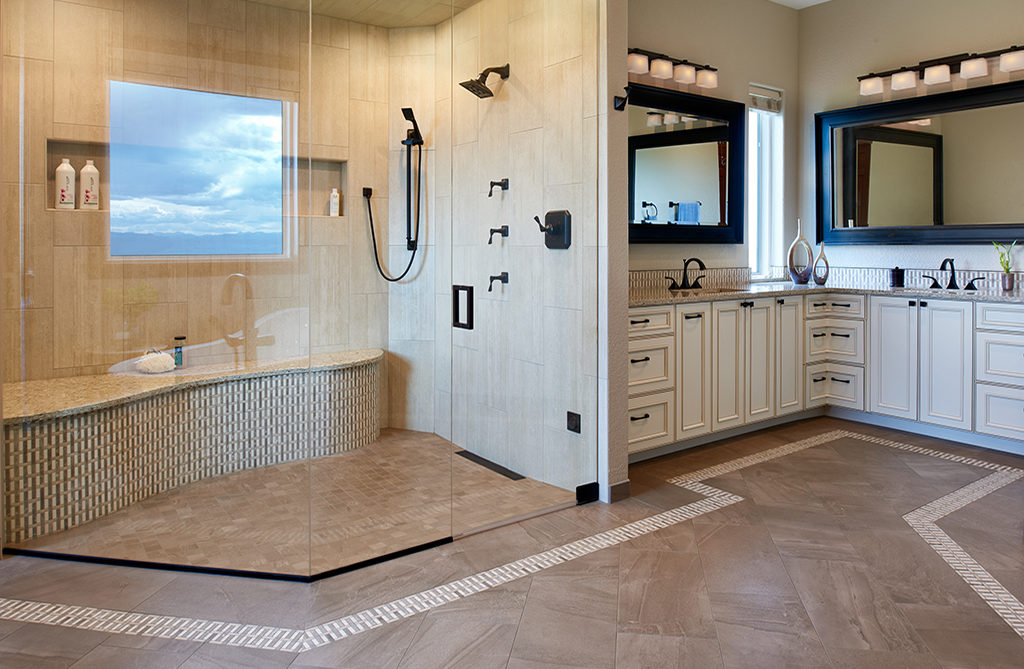We take pride in every product that we place in your home. The selections we’ve made for you are an investment and we want to help you keep these investments in beautiful and functional condition.
We’ve listed these general recommendations for taking proper care of common products. You will also find a link to our DropBox library with a collection of detailed instructions from the manufacturers.
Stained and Painted Cabinets

Stained and Painted Kitchen Cabinets
Maintenance:
Wipe the surface with a soft cloth to remove most debris and dust, and use a wood-friendly cleaner for more stubborn stains. Stained and painted cabinets can be washed with soap and water.
If the surface of the cabinet becomes chipped or marked, and you need to touch up the finish, you will find that stains blend better with the existing finish, particularly if the cabinet has a lot of grain to it. Paint is often created in dye lots that can vary from can to can, which means that in order to touch up a small area; you will need to repaint the entire cabinet.
Note: Cabinet orders that are placed through Beautiful Habitat receive a touch-up kit with delivery
Stone (granite, quartzite) and Engineered (quartz) Countertops
Cleaning:
All solid surface countertops should be cleaned with water and mild dish soap and a soft cloth or nonabrasive sponge. For dried spills or heavy stains, let the water and soap sit on the stain for 10 minutes, then gently scrub with a nonabrasive sponge
Avoid:
- Never use abrasive cleansers and avoid scouring pads, or steel wool, which can dull the surface.
- Acid or Alkaline Cleaners
- Household acids including vinegar, lemon, lime, and citrus
- Ammonia or ammonia-based cleaners like Windex
- Harsh cleaning solutions at both ends of the pH spectrum. Culprits include products from nail polish remover and turpentine to drain cleaner and dishwasher rinsing agents. Whether highly acidic or highly alkaline, those chemicals can damage all types of countertops.
If any of the substances mentioned above come into contact with your countertop, rinse the exposed surface immediately and thoroughly with water.
Hardwood Floors
General Tips:
Put stick-on felt protectors under the legs of furniture to prevent scuffing and scratching. Replace these often as dirt and debris can become embedded on the pad and act like sandpaper on the flooring surface.
Use throw rugs at doorways to help prevent debris from being tracked in and scratching the floor.
Cleaning:
Use a dust mop or vacuum to remove dirt, dust, and other debris that could scratch the floor. Don’t use a vacuum with a beater bar attachment as it could damage the surface of the floor. Use the floor-brush attachment. Depending on traffic and the number of pets and children you have, you’ll need to do this at least once a week.
For periodic deep cleaning, you’ll need to use water and potentially a liquid cleaner. Before you use a commercial wood-cleaning product or vinegar, check with the flooring installer to confirm the product is safe for your specific flooring finish. Be sure to follow manufacturer’s instructions.
Whatever cleaner you choose, the process for how to clean wood floors and engineered hardwood floors is the same. Saturate a rag or sponge mop in your cleaning solution. Wring it out thoroughly so the mop is damp, not wet. Mop the floor with the cleaner, being careful to not put too much liquid on the floor. Rinse the mop with clean water, wring out excess, and damp mop the floor to remove the cleaner. Wipe up excess water with a clean, dry towel because standing water will damage the floor.
Tile Floors

Maintaining Tile Floors in your Home
Cleaning:
Sweep or vacuum your tile floors a couple of times a week. Sand and grit can dull and scratch the surface. Once you’ve removed the dirt, you’re ready to mop. Mix a mild detergent with hot water and apply with a rag or chamois mop instead of a sponge mop. A sponge mop pushes dirty water into the grout and soils it. Change your bucket of cleaning solution often so you won’t have a dirty mop that leaves a cloudy film of dirt on the floor. If you do end up with a hazy film on your tile floor, remove with an all-purpose cleaner. Make sure it’s non-abrasive so it won’t scratch the floor. You can also make your own cleaner by mixing lemon juice or vinegar with hot water. Apply it to the floor and then buff dry with a clean cloth. You can use a towel that you push over the floor with your foot.
Grout Cleaning:
One of the most important things in knowing how to clean tile floors is keeping the grout clean. Dirty grout equals dingy-looking floors. Grout is porous and easily absorbs dirt, grease and other materials. Spray the grout with a commercially prepared grout cleaner. You can also use a mild bleach solution. It’s a good idea to wear gloves when using these types of products. For deep stains, allow the cleaner to sit for 10 minutes. Use a toothbrush or other small scrub brush to scrub the grout.
For stubborn grout stains, mix a paste of baking soda and water. Apply it to the stain, let it sit overnight and then scrub with a nylon brush. Don’t use a metal brush as it will scratch the tile. Let the grout air dry, then put on a silicone-based grout sealer to resist future stains and dirt.
Removing Stains from Ceramic Tiles:
Here’s how to clean ceramic tile that has been stained. For coffee, tea or juice stains, wash the tile surface with hot water and detergent, then blot with hydrogen peroxide. For grease stains, wash with club soda and water, or a commercial floor cleaner. For ink stains, soak a cloth in diluted bleach and lay it on top of the stain. Leave the cloth until the stain is gone. Rinse thoroughly when done.
Natural Stone, Marble, Travertine, Limestone and Granite Floors
Natural stone material, granite and marble floors are beautiful additions to any home, however, care must be taken to keep them clean and free of damage. Although strong and hard, these surfaces are very porous and the surface can be easily stained and the polish marred. Always follow the manufacturer’s instructions and use the cleaning products recommended when possible. Below are some safe cleaning tips for these surfaces.
Do’s and Don’ts:
- Don’t use products that contain lemon juice, vinegar or other acids on marble, limestone, or travertine, these will mar the surface
- Don’t use abrasive materials like steel wool, microfiber scrub pads, scrapers or abrasive cleansers on these materials as they will scratch the surface
- Don’t use ammonia-based cleaners, they will dull the surface
- Do use a sealant on your stone surfaces when installed and refresh as specified by the manufacturer
Things You’ll Need:
- Neutral pH all-purpose cleaner, or neutral pH dish soap
- Rotating microfiber mop handle with microfiber towels or a wet mop
- Vacuum with rotating brush deactivated or Broom
- Bucket
- Water
How to Clean:
- Vacuum or sweep the floor to remove any dirt particles.
- Fill a bucket with a gallon of warm water and use just the water or mix in a small amount of Neutral All-Purpose-Cleaner, Dish Soap or the manufacturers recommended cleaning solution. Change the solution when it gets cloudy or dirty.
- Dip the microfiber towel into the water mixture, ring thoroughly, attach to the mop handle and begin cleaning or use the Wet Mop.
- Wash the floors by starting at the outermost corner of the room and working methodically towards the room exit.
- Allow the floors to air dry
Acrylic bathtubs and shower pans
Your new acrylic bathtub is tough, durable and easy to care for. The high gloss surface will retain its lasting luster with proper care and maintenance.
Always fill the tub with temperate water. Excessively hot water (greater than 130° F) may cause surface damage.
Clean after use with a mild liquid household detergent cleaner. Do not turn on jets when such cleaners are present.
Use of abrasive cleaners or powders will dull the surface. If the glossy surface looses its sheen, dulled areas can be partially restored by rubbing with a white automotive body polishing compound and waxing with a liquid wax. Do not wax surfaces where you walk or stand.
Do’s and Don’ts:
HARSH CHEMICALS, SHARP AND ABRASIVE OBJECTS SHOULD NEVER BE USED ON ACRYLIC SURFACES.
- Do not use: Lestoil® Cleaner; Lysol® Disinfectant (spray or concentrate); or Lysol® Basin, Tub and Tile Cleaner; Windex® Cleaner; Mr. Clean® Cleaner; Dow® Disinfectant Bathroom Cleaner; or other cleaning products in aerosol cans.
- Do not use wire brushes, knives or sharp objects to remove stains or other surface blemishes.
- Do not allow nail polish remover, acetone, dry-cleaning fluid, paint remover, or other solvents to come into contact with the surface.
- Clean the surrounding surface immediately after using caustic drain cleaners.
- Burning cigarettes will irreparably damage the surface of the tub.
